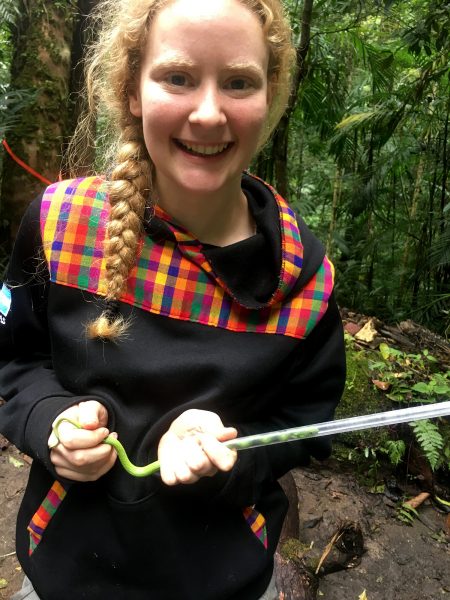Georgia Southern graduate student conducts research as snake specialist in Honduras
Lauren Wilson, a graduate student in the Georgia Southern University Department of Biology, spent the summer working as a snake specialist in Central America. Wilson joined a research team tasked with quantifying and protecting biodiversity in the forests of Cusuco National Park in Honduras. The team was organized by the conservation research organization, Operation Wallacea.

Wilson was invited to apply her herpetology skills to an ongoing project that monitors plant and animal diversity at Cusuco National Park in the Merendon Mountains of northwest Honduras. These mountains support globally significant biodiversity, including a remarkable variety of amphibians and reptiles found nowhere else in the world.
Wilson’s specific responsibility was handling snakes that were encountered in a safe way, including venomous species.
“I coax the snake into a long plastic tube of an appropriate diameter,” Wilson said. “Once it’s in the tube, the snake can’t bite or turn around. At that point, it is safe for me to handle the snake, take the necessary data, such as a DNA sample, and then release the snake unharmed.”
She was also responsible for conducting surveys to identify and count other amphibians and reptiles, as well as collecting research data from each animal that was encountered.
To survey amphibians and reptiles, Wilson and others searched predetermined routes through the forest. By repeating these surveys over time, biologists can assess whether populations are increasing or decreasing. Measurements and weight were recorded for each animal, as well as any other critical data, such as swabbing the skin of frogs in order to test for the presence of a deadly fungus.
Part of Wilson’s work as a snake specialist included carrying out her own research on the evolution of color patterns in snakes. Many snake species in Central America mimic the color patterns of venomous coral snakes, with varying degrees of accuracy. To find out how successful the mimicry is and to see if the presence or absence of a coral snake model affects the evolution of mimicry, Wilson created life-size clay models with different color patterns and placed them into sites with and without coral snakes.
“I retrieved the models a few days later,” Wilson said. “By looking for teeth or beak marks in the clay, I can quantify which color patterns are most effective at deterring predators at different sites.”
Assistant professor of biology, Christian Cox, Ph.D., who is Wilson’s major advisor and a collaborator in the Honduran research, said Wilson’s research is an important study of the evolution of snake color patterns.
“Lauren’s research is important because she is quantifying how sharing habitat with coral snakes affects the evolution of mimicry,” Cox said. “Her research is some of the first to study predation and coral snake mimicry in the montane tropics, where sites with and without coral snakes are in close physical proximity due to abrupt elevational changes.”
This is the second consecutive year that Georgia Southern graduate students have played a significant role in research work at Cusuco National Park. The Department of Biology hopes to continue this productive relationship in the future.
Georgia Southern University, a public Carnegie Doctoral/R2 institution founded in 1906, offers 141 degree programs serving nearly 26,500 students through nine colleges on three campuses in Statesboro, Savannah, Hinesville and online instruction. A leader in higher education in southeast Georgia, the University provides a diverse student population with expert faculty, world-class scholarship and hands-on learning opportunities. Georgia Southern creates lifelong learners who serve as responsible scholars, leaders and stewards in their communities. Visit GeorgiaSouthern.edu.
Posted in Press Releases, Research

